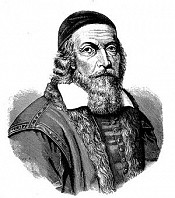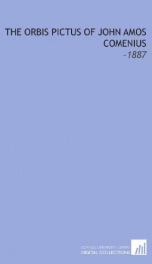Comenius Johann Amos

John Amos Comenius (Czech: Jan Amos Komenský; Slovak: Ján Amos Komenský; German: Johann Amos Comenius; Polish: Jan Amos Komeński; Hungarian: Comenius Ámos János; Latinized: Iohannes Amos Comenius) (28 March 1592 – 15 November 1670) was a Moravian teacher, scientist, educator, and writer. He was a Unity of the Brethren/Moravian Protestant bishop, a religious refugee, and one of the earliest champions of universal education, a concept eventually set forth in his book Didactica Magna. Comenius became known as the teacher of nations. He is often considered the father of modern education. The birthplace of Comenius is not known. There are three possible locations: Komňa, Nivnice, or Uherský Brod in Moravia (all three locations are in Uherské Hradiště District, Czech Republic). His ancestors came from Hungary during the 16th Century and his original family name was Szeges (his first name was János Szeges) according to his will found in 1968 by Milada Blekastad, a monographer of Comenius. He attended the Latinschool in Přerov, Moravia, where he returned 1614-18 as a teacher of the school. He continued his studies in Herborn (1611-13) and Heidelberg (1613-14). Comenius was greatly influenced by the Irish Jesuit William Bathe as well as his teachers Johann Piscator, Heinrich Gutberleth, and particularly Heinrich Alsted. The Herborn school held the principle that every theory has to be functional in practical use, therefore has to be didactic, ie morally instructive. Comenius had a few wrinkles on his mentors' thoughts later published in Janua linguarum reserata (1631) which may have made him and the Moravian Church especial targets of the Counter Reformation. Alternately, the work may have resulted from the pogroms which drove him and his church out of its homeland into exile, but in any event, the work led him to widespread prominence and fame while suffering exile. Comenius became a pastor at age 24 and led the Brethren into exile when the Protestants were persecuted under the Counter Reformation. He lived and worked in many different countries in Europe, including Sweden, the Polish-Lithuanian Commonwealth, Transylvania, the Holy Roman Empire, England, the Netherlands, and Royal Hungary. Comenius took refuge in Leszno in Poland, where he led the gymnasium, then moved to Sweden to work with Queen Christina and the chancellor Axel Oxenstierna. From 1642-1648 he went to Elbing (Elbląg) in Polish Royal Prussia, then to England with the aid of Samuel Hartlib, who came originally from Elbing. In 1650 Zsuzsanna Lorántffy, widow of George I Rákóczi prince of Transylvania invited him to Sárospatak. Comenius remained there until 1654 as professor in the first Hungarian Protestant college; he wrote some of his most important works there. Comenius returned to Leszno. During the Northern Wars in 1655, he declared his support for the Protestant Swedish side, for which his house, his manuscripts, and the school's printing press were burned down by Polish partisans in 1656. From there he took refuge in Amsterdam in the Netherlands, where he died in 1670. For unclear reasons he was buried in Naarden, where his grave can be visited in the mausoleum devoted to him. One of his daughters, Elisabeth, married Peter Figulus from Jablonné nad Orlicí. Their son, Daniel Ernst Jablonski, Comenius's grandson, later went to Berlin, where he became the highest official pastor at the court of King Frederick I of Prussia. There he became acquainted with Count Nicolaus Ludwig Zinzendorf. Zinzendorf was among the first successors to Comenius as bishop in the renewed Moravian Brethren's Church. Comenius, his life and teachings, have become better known since the fall of the Iron Curtain. His book, Labyrinth of the World and Paradise of the Heart, is actually a reflection on his life experiences. Other works include Janua Linguarum Reserata (a new Dutch translation by CFJ Antonides is available) and Orbis Sensualium Pictus (World in Pictures) (1657), probably the most renowned and most widely circulated of school textbooks,[1] and the Protestant Hymn songbooks (Gesangbuch). According to Cotton Mather, Comenius was asked to be the President of Harvard University, but moved to Sweden instead.[2] He also attempted to design a language in which false statements were inexpressible.[3] During the 19th century Czech National Revival, Comenius became idealised as a symbol of the Czech nation. This image persists to the present day. In Sárospatak, Hungary, a teacher's college is named after him (the college now belongs to the University of Miskolc.) 28 March, the birthday of Comenius, is celebrated as Teachers' Day in Slovakia and in the Czech Republic. The Comenius Medal, one of UNESCO’s most prestigious awards honouring outstanding achievements in the fields of education research and innovation, is named after him. In 1892 Comenius Hall, the principal classroom and faculty office building on Moravian College's campus, was built. In 1892 the three-hundredth anniversary of Comenius was very widely celebrated by educators, and at that time the Comenian Society for the study and publication of his works was formed.[4] In 1919 the Comenius University was founded in Bratislava, Czechoslovakia, (now in Slovakia). It was the first university with courses in the Slovak language. "Comenius" a European Union school partnership program has been named after the teacher of nations. The education department at Salem College has an annual Comenius Symposium dedicated in his honor; the subjects usually deal with modern issues in education. Gate to Languages, a project of lifelong education, taking place in the Czech Republic from October 2005 to June 2007 and aimed at language education of teachers, was named after his book Janua linguarum reserata (Gate to Languages Unlocked). A primary school in Skopje, Republic of Macedonia is named after Comenius (Jan Amos Komenski in Macedonian). The school was built by the Czechoslovak government after the catastrophic earthquake in 1963 that levelled most of Skopje. The Comenius Foundation is a non-governmental organisation in Poland, dedicated to the provision of equal opportunities to children under 10 years of age. The great Italian film director Roberto Rossellini took Comenius, and especially his theory of "direct vision," as his model in the development of his didactic theories, which Rossellini hoped would usher the world into a utopian future.[5] There is also a Comenius Foundation in the US, a non-profit charity that uses film and documentary production to further faith, learning, and love.
do you like this author?
What readers are saying
What do you think? Write your own comment on this book!
write a commentWhat readers are saying
What do you think? Write your own comment on this author!
write a commentBook list

The Orbis Pictus
Series:
Unknown
Year:
Unknown
Raiting:
3.5/5
The Orbis Pictus was written by Johann Amos Comenius, known as the father of modern education in 1887 and is considered to be the first book intended for children. The book includes a number of topics necessary for the education of children. The author addresses the problems of Christian cosmology, history and household issues from the point of view of the 17th century. However, the book does not seem to be old. It would be interesting for students of history and literature, everyone who cares about his/her children and wishes to teach them something new and apply some new methods in their education.
Show more
add to favoritesadd In favorites
Book list

The Orbis Pictus
Series:
Unknown
Year:
Unknown
Raiting:
3.5/5
The Orbis Pictus was written by Johann Amos Comenius, known as the father of modern education in 1887 and is considered to be the first book intended for children. The book includes a number of topics necessary for the education of children. The author addresses the problems of Christian cosmology, history and household issues from the point of view of the 17th century. However, the book does not seem to be old. It would be interesting for students of history and literature, everyone who cares about his/her children and wishes to teach them something new and apply some new methods in their education.
Show more
add to favoritesadd In favorites
What readers are saying
What do you think? Write your own comment on this author!
write a commentGenre
if you like Comenius Johann Amos try:
readers also enjoyed
What readers are saying
What do you think? Write your own comment on this author!
write a commentGenre
if you like Comenius Johann Amos try:
readers also enjoyed
Do you want to exchange books? It’s EASY!
Get registered and find other users who want to give their favourite books to good hands!

